 This is the story and living review of the development of Dreamride's Sal Sal Mountain Loop Moots Vamoots YBB build.
This is the story and living review of the development of Dreamride's Sal Sal Mountain Loop Moots Vamoots YBB build.by Lee Bridgers.
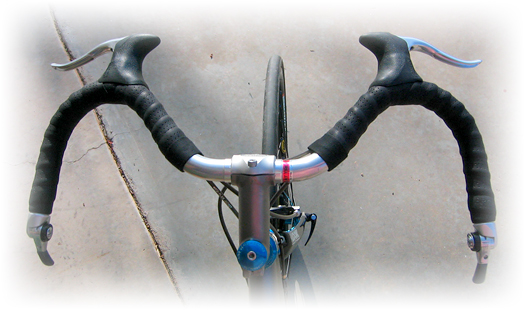 UPDATE 4/1/08
UPDATE 4/1/08
The shop Vamoots is now outfitted with a mustache bar cockpit inspired by our 9er conversion kits. Also pictured here is a Psychlo-X with La Sal Mtn Loop build including the Nitto mustache bar. We have been using the mustache with 9er and cyclocross frames and I have grown to love it for road and light off-road use. The Nitto mustache bars, Shimano Bar Con shifters, and Brooks leather bar tape create a sleek classic look and a unique feel and position on the bike that is spot on for Moab roads and city traffic. This is by far the most comfortable set up to date. Positions provided by the mustache bar include power climbing, handling, and aero. The aero position is a very efficient and comfortable move to the hoods, placing you farther forward and toward the middle for a flatter back without being way low in the drops, more like a tri bike than a road bike. Braking is more positive due to the more ergonomic wrist position. This is one of the best modifications to any kit we have formulated! Because shifting is not at your fingertips in two of the three positions on the bike, we don't recommend this set up to inexperienced riders. It will take a bit of getting used to if you are not at ease on a road bike, but once even the most jaded roadies give the mustache a try, everyone agrees that it provides a very effective option, especially for city commuting.
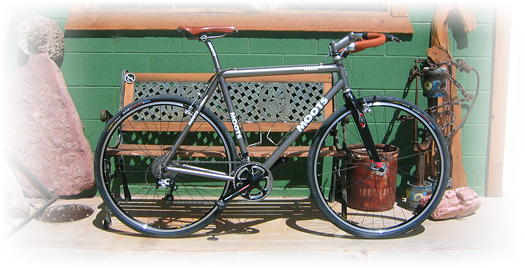 UPDATE 8/1/07
UPDATE 8/1/07
PARTS OPTIONS
In 2007 I ditched Campy on the LOOP build for Shimano's compatibility, strength and reliablity. I also added Paul in-line levers to allow you to cover for the squirrel, dog or small child that runs out in front of you while you are speeding along in the center of the bar for aero reasons. We also added Zero Gravity brakes for Vamoots versions, which are simply the best of the best. Not that the Campy or Shimano brakes are not fantastic. The Zeros are just much lighter, have a rock solid feel and are a huge advantage in the wet (be careful!). Cosmetics may suffer, but some like the industrial look, especially on a Moots.
YBB TESTING UPDATE
The ride that inspired this project is called the La Sal Mountain Loop Road, a 65 mile grunt and white-knuckler that travels up and over the La Sal Mountains, down through Castle Valley on a rail and back to Moab via the twisty, sometimes busy and dangerous Colorado River Road. This trek features some of the roughest road in Utah with a section of dirt and gravel at the highest elevation to wake you up after the torturous climb. It is arguably one of the most scenic road rides anywhere, combining serious steep elevation gain and a fast descent on twisty and steep grades, with a rolling finale through the Colorado River Gorge. The idea of focusing on this particular ride was personal, a tribute to Moab's incredible road rides now coming out of the shadow of its spectacular mountain biking. A bike built for this specific ride had to possess user friendly traits in just about every road riding environment. The bike is light and geared for comfortable climbing, vertically compliant and ergonomically happy on bumpy road surfaces. It possesses a balanced feel, combining stable handling, lateral rigidity and vertical compliance. After much deliberation the Moots Vamoots YBB frame brought total clarity to the project. The La Sal Mountain Road Moots Vamoots YBB is my personal favorite for training, recreational distance riding, road guiding, credit-card touring and century rides. It can even take you off road, if you ask it with respect.
The YBB difference is best experienced with a minimalist road saddle, but if you are a minimalist, you are probably not looking at YBB in the first place. After riding this bike for a few years, the YBB feature may be overkill for anyone living in a place where the roads are well maintained, but I find myself loving the option here in Moab where the roads simply suck. The YBB circuit remains locked out most of the time at this point in my experience with this bike (which will last the rest of my life--titanium lasts forever!). If I am tired and heading down a bumpy flat road (like that long stretch from town to Ken's Lake), I stop and free it up. It works great when I need it and I need it a lot in Moab! My main concern with using the YBB all the time is that I actually like to feel the road surface under my ass--it is a reassuring reminder that I am contacted to the ground and that my rear wheel is ready to scoot. The YBB has a funky feeling during hard braking at speed, which is why I prefer to lock it out on fast descents. This frame actually has enough travel that it has its own version of brake dive. And, when I am sprinting on smooth pavement, I don't want that YBB to rob me of acceleration. The frame already has that sweet compliance of titanium, so I must tell anyone thinking of the YBB feature on a road bike that: 1) It adds weight; 2) It works--does the job of making small bumps disappear and vibration disappear at the saddle; 3) You can lock it out and it disappears, except for the minimal weight; 4) There will come a time when you look at it and it just seems ugly; 5) There comes a time when you are soooo happy you have it.
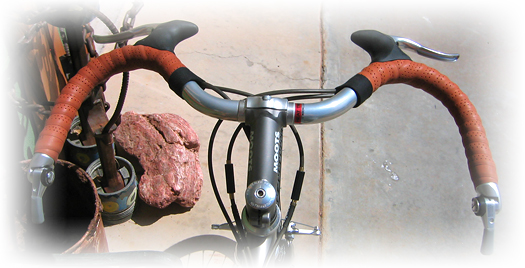 Working it out with tradition--the LOOP idea
Working it out with tradition--the LOOP idea
A few years ago I purchased a Moots Vamoots YBB frame to dress, test and call my own. I crowned this 56cm Vamoots YBB with a special Dreamride grouppo designed around a legendary road ride from our shop in Moab. On the way to perfection I researched every high end frame and component from every reputable company worldwide over five years, ending up with authorized dealerships for three bike lines that produce frames worthy enough to consider, Moots, the obvious final choice, De Rosa and Kestrel, excellent frames certainly worthy of this build, but not the ultimate choice. The only other frame we will put this build on is now a Pegoretti, which we can have custom built to suit this idea. We still offer De Rosa and Kestel frames, but don't actively advertise them. Moots and Pegoretti is where WE are, so why tell you different. Get a De Rosa for racing to the cafe. Get a Moots for riding the mountains. Get a Pegoretti to start your own modern art museum.

THE HISTORY OF THE LA SAL MOUNTAIN LOOP PROJECT
We picked up Moots in 2002, a logical choice to replace Ibis that went the way of the dinosaurs earlier in the year. We were contacted by Moots at the perfect moment, and knowing the high quality, we could not resist. At this time, we were focusing solely on the "freeride" soon-to-be "all mountain" end of cycling. I knew Moots was going to take us down a different road. I never imagined that the road would be a literal road. Moots mountain bikes, while certainly among the best, were not seen as suitable for Moab terrain. But, not all of mountain bikers live in Moab, so I saw an opportunity to offer a legendary titanium hardtail, the original YBB softail design, and the simple and straight-forward Smoothie, now replaced by the Zirkel. The Cinco has been our most popular 5 inch travel mountain bike. The Moots bikes are what I would choose for places I have lived and ridden in the past--the San Francisco Bay Area, the mountains of Virginia, North Carolina, and Colorado. I knew the Moots road bikes were as close to the Ibis roaders--true gems--but I must admit it did not sink in until we bought one.
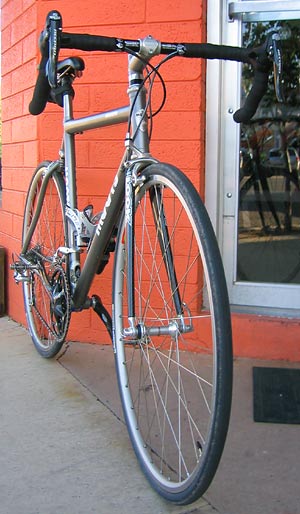 Like I said, we started this project with De Rosa, always been a personal favorite. The Italian mystique, styling, the use of every exotic frame material, and the thread to tradition add up to an image, an ultimate accomplishment in road cycling. I decided to look into De Rosa's titanium frames. I was shocked to discover the price of a De Rosa titanium frame far exceeded that of their Carbon King, which was ALREADY stupid expensive. I looked closely at the welds of the De Rosa titanium frames, the over-all construction, the dropouts, the headtube and it was not hard to see that Moots built a better titanium frame costing far less. AND they are nearby in Steamboat Springs.
Like I said, we started this project with De Rosa, always been a personal favorite. The Italian mystique, styling, the use of every exotic frame material, and the thread to tradition add up to an image, an ultimate accomplishment in road cycling. I decided to look into De Rosa's titanium frames. I was shocked to discover the price of a De Rosa titanium frame far exceeded that of their Carbon King, which was ALREADY stupid expensive. I looked closely at the welds of the De Rosa titanium frames, the over-all construction, the dropouts, the headtube and it was not hard to see that Moots built a better titanium frame costing far less. AND they are nearby in Steamboat Springs.
So, I began considering the Moots Vamoots for the La Sal Loop build. It did not take long before the YBB softail system came into play. Taking a good look at the YBB specs, photos in the Moots catalog, and listening to testimonials from the Moots crew made the choice obvious. The Vamoots YBB was the best hope for making this build as good as it could be, even better than I could have imagined, as you will read in the following review of the bike's history. The simple suspension system of flexing chainstays and a small spring damped by a simple tightening collar was just too logical, too "mountain bike" to ignore. And, if you don't want it, lock it out (by the way, you can change the geometry of the bike by locking down the YBB in different positions--something I do when roads are smooth). After a few years on the bike, the YBB is locked out most of the time, but when I need it, it is ready to save my aching back and sore ass.
La Sal Mountain Loop is a ritual of self-sacrifice, a training method to get ready for longer mountain bike rides, and a macho "look what I did" deal for the recreational cyclist. A solid, fit, experienced road rider would have no problem with the Loop, but we are mountain bikers, guys who ride really tough intervals for money. After a period off the bike, or during the horrible heat of summer, the Loop is ridden, followed by stories of stuff vomited up and emergency cell phone calls made from Castle Valley to get someone to bring water and a hamburger. After serious training the loop can be ridden in around four hours from town (not me, by the way--I like to go up there to BE there and if I put in the energy, I am enjoying the mountain air and the trees by stopping, going slow), but there is the road itself. It is incredibly bumpy, to say the least. A long steady uphill, sometimes against the wind, on chip seal and over cattle guards and potholes. The chip seal nags you for miles prior to a series of steep, steep, steep climbs to the shoulder of the range. Then you descend on twisting switchbacks, steep, steep, steep again. This is the second youngest mountain range in the world. It is hardly eroded. Hands go numb. Butts go numb. Legs go limp. Fingers go numb. Teeth get chipped.
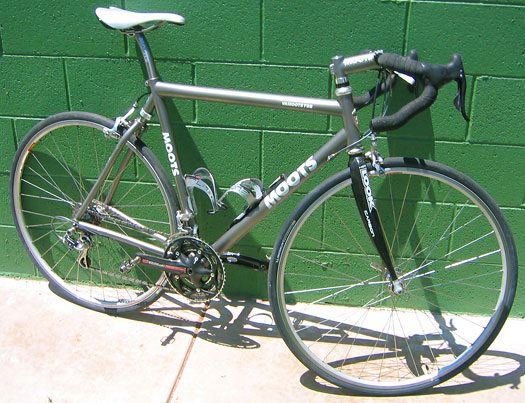
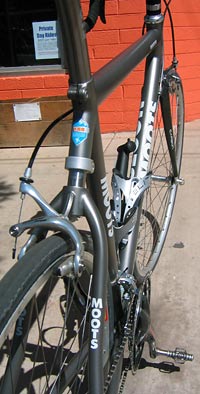
THE 2003 BUILD
As my frame was being built at Moots, I did specific research on components. Being a stupid mountain biker, the one part that kept my focus over the initial formulation of the grouppo, something I later decided against, was the Marzocchi Pave fork, a short travel road fork built by Marzocchi in 1998 at a time when suspension manufacturers were competing for a perfect way to make more money off of those road geeks. That famous Paris Roubaix race over Roman cobblestones was the excuse. When it was found that road racers were not that impressed, preferring lightness and tuned compliance over actual suspension (titanium forks work best for cobblestones), these fork projects folded, leaving Pave forks unbuilt in boxes at Marzocchi America. I ordered a couple, but this fork weighed 3 pounds, was held together by bolts, and looked like a plumber's nightmare. I moved on to a distance racing fork made in Japan that basically swiveled at the dropouts to absorb road shock from potholes and small imperfections in road surfaces. After trying it on the YBB, I found that the Japanese fork conflicted with most rim brake surfaces. It was light, ALMOST right, but it left me with rim choices that I did not like. This was a VERY good thing, because the failure of these suspension forks moved my focus more toward weight bias favoring the true advantage of the YBB frame. Choosing an offset seatpost and a higher, shorter stem, I was seeking methods of softening the handlebar with ergonomics, gel and carefully placed added cork. Hello, carbon fiber forks.I purchased a range of parts, changing components constantly. This is the rather large financial sacrifice Dreamride makes every time I research a grouppo. Drivetrain parts evolved without problem. Shimano Dura Ace or Campy Record? I chose Campy with a couple of substitutions for the initial version. The most recent road bike I owned was decked out in Campy Chorus. I had absolutely no complaints. Campy parts, for the most, are rock solid, and sylish. By comparison, Shimano parts seem heavy, clunky and clumbsy looking. Campy's hubs and freehub body seemed flawless, strong and easy to work on, though I later found cassette cogs to be flexy as compared to Shimano (and costing about twice as much). While Shimano's shifting is more crisp, the fit and function of the the Campy levers were far more desirable for a bike that might be taken off-road. If I were racing, I would go with Shimano Dura Ace, but the Campy shifting just felt right at the time, especially due to the fact that you could shift from the top of the bar.
There is one place in the drivetrain where I veer to China: FSA's carbon cranks and titanium bottom bracket are much more cost-effective than Campy's Record carbon. Campy's carbon crankset, while fancy and cool, was not better than the FSA at half the price and twice the performance. As most of road riders out there will tell you, Campy 10 speed chains break. I went with a Conex. No fancy tools, just rock solid reliability. When I made the switch to the Shimano Dura Ace 9 speed cassette, the Conex Wipperman worked even better.
Personally, the idea that a road bike has to be uncomfortable is not a justification for buying "parts that Lance uses." During the intial testing, I messed with combinations, a variety of good choices actually, of Moots, Deda, FSA, Easton, Kestrel, WTB and Ritchey parts for the upper end of the bike. Parts like this are always decided with flexibility in mind. Sometimes a client's needs to override a stock choice during consultation when a purchase takes place, . . . but for me there has to be a zero setting. Sometimes parts change for specific needs. Everybody has a different body and different intentions. The fit of parts that come in direct contact with hands and butt, defining the position of a rider's body over the frame, are best decided during a conversation with each client, but in order to be able to get it right, I have to have a place to start. The choice of the YBB system had a huge effect on these choices. Moots recommends the YBB system for anyone with a "back pain," because the rider position can be more upright without causing the even more severe "ass pain." A pain in the ass is just what it sounds like--pain in the ass that goes right up to the brain via the backbone. This is just one reason why road racing bikes balance weight over the pedals, with the ass and the hands balancing the fore-aft static position to avoid too much pressure on either end.
The YBB-Mountain Road formula became more and more a hybrid (and even became a hybrid at one point), biased toward distance road riding and urban and mountain treks. Since the rear of the bike is soft, with about an inch of suspension travel, the rider's weight can be shifted more onto the saddle than in the case of fully rigid frames. Since I am a mountain biker, first, and a road nerd, third, I truly relished the idea of placing more weight on my ass than on my hands at the start of the build. I like the ability to float over rough stuff and the roads around Moab certainly take a lot out of your hands. I also like to get back for obstacles and place more weight on the rear tire while out of the saddle for even braking. I like to be able to see the scenery, too, as well as road irregularities, and the stupid cars in front and behind (watch out for the cowboy hat in the red and white pickup!). After all, if it were just about spinning, I could do that in my livingroom listening to Eminem on the stereo. Because I love to ride in the real world and actually enjoy the smells of nature, a more upright position was welcome as long as I was able to stretch out and be aerodynamic when needed.
The thought process in setting up the drop bars was: You need to be able to tuck in for aerodynamics and keep the front wheel on the road, but most of the time, it is more important to enjoy the ride, the scenery, the lack of pain, the ass of the female rider in front of you, and whatever else scopophiles get off on. I want my neck to be without pain. I want my arms to have feeling in them. I want may ass to not even know it is on a bike. YBB helped. A tad of rear suspension is just the ticket for the upright rider. The handlebars get gel pads and custom corking, the stem gets a bit shorter, the bars just a bit higher. You can slide back onto the YBB cushion when you want it or you can hunker down. The YBB spring, offset titanium post and rider body position that favors power "from behind" took care of MOST bumps and the pain. The bike remained fairly laterally rigid with that wonderful titanium feel and it didn't get hooked up on little rocks or pot holes (keep the tire pressure high). If I want to sprint or travel on a smooth road, I just lock out the YBB with an allen key. With the drop bar setup I grew to love riding the road again, whereas before, with an older steel frame and a road racing position, I looked at it as a form of religious self-torture. I did it for training. Now I do it because I just cannot resist hopping on that great bike.
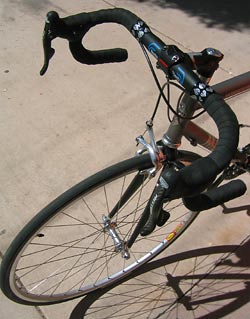 The drops: To achieve the correct position, I make sure that I abide by the old rule of the handlebar obscuring the front axle when the rider is in the drops. I chose handlebars with shallow drop, no deeper than 140mm. Ergo bars are a treat, but there are so many options. I tried almost every one, and liked almost every one. The new larger tube diameter of high tech road handlebars has carried over into mountain bikes, but using the larger diameter bars and carbon fiber means that you must forgo the use of the inline levers. I appreciate the super light weight and tuned feel of the super sexy high tech carbon products from Deda or FSA. I also tested the "world's lightest road bar" from Easton. For our road racing builds, these are fantastic, but none were appropriate for the La Sal Loop. There are truly great ergo bars our there--from Easton, Cinelli, Deda, Kestrel, FSA and other manufacturers and an amazing selection of (questionable)stems. Moots ti stems are simply the best, so that is what I am using now for all Moots road bikes. The match, they don't break and they are light.
The drops: To achieve the correct position, I make sure that I abide by the old rule of the handlebar obscuring the front axle when the rider is in the drops. I chose handlebars with shallow drop, no deeper than 140mm. Ergo bars are a treat, but there are so many options. I tried almost every one, and liked almost every one. The new larger tube diameter of high tech road handlebars has carried over into mountain bikes, but using the larger diameter bars and carbon fiber means that you must forgo the use of the inline levers. I appreciate the super light weight and tuned feel of the super sexy high tech carbon products from Deda or FSA. I also tested the "world's lightest road bar" from Easton. For our road racing builds, these are fantastic, but none were appropriate for the La Sal Loop. There are truly great ergo bars our there--from Easton, Cinelli, Deda, Kestrel, FSA and other manufacturers and an amazing selection of (questionable)stems. Moots ti stems are simply the best, so that is what I am using now for all Moots road bikes. The match, they don't break and they are light.
The rear biased rider position required smart choice in seatpost and saddle. The saddle needed to be soft, if not plush--you are going to be sitting on it with more weight due to tempting comfort offered by YBB. The seatpost has to be strong and resist slipping in the collar. With the drop bar, I used the offset Moots post and a Fizik Aliante saddle.
THE RIDE
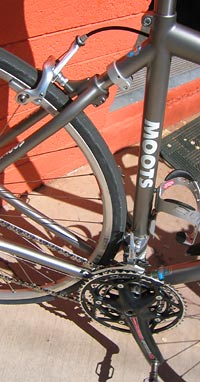 My favorite road bike of the past was a Puch frame built by Bianchi with Campy Chorus drivetrain. It was a steel frame built from an early 90's Columbus rifled TSX tubing. I bought on sale from a shop in San Francisco and used it in the city and when I moved to Colorado to ride the front range. Overall the bike was stiff and it transmitted road vibration. It had that bike shop store-bought "I'm a stupid wannabe racer" fit. Once on my Vamoots YBB I instantly became a true believer in the importance of custom fit. The comfort made me a road rider once again, and a born again titanium nut. I own a 1993 Fat Chance Titanium mountain bike, my guide bike for the first two years we were in business in Moab. I hadn't ridden it for years until after I started riding the Vamoots. Titanium works and is addictive!
My favorite road bike of the past was a Puch frame built by Bianchi with Campy Chorus drivetrain. It was a steel frame built from an early 90's Columbus rifled TSX tubing. I bought on sale from a shop in San Francisco and used it in the city and when I moved to Colorado to ride the front range. Overall the bike was stiff and it transmitted road vibration. It had that bike shop store-bought "I'm a stupid wannabe racer" fit. Once on my Vamoots YBB I instantly became a true believer in the importance of custom fit. The comfort made me a road rider once again, and a born again titanium nut. I own a 1993 Fat Chance Titanium mountain bike, my guide bike for the first two years we were in business in Moab. I hadn't ridden it for years until after I started riding the Vamoots. Titanium works and is addictive!
My first impressions of the Vamoots are most important to understand. The very first ride on the "Loop" Vamoots YBB drop bar bike was the long slightly uphill section of La Sal Mountain Loop; the ride out of town on Spanish Valley Road to Ken's Lake and back. It was uphill with the wind on the way out, and downhill against the wind on the way back. The most stunning aspect of the first ride was the YBB rear end. The horrible pot-holed, rough pavement on the road just prior to Ken's Lake was softened deliciously. I cannot say enough good things about how the YBB softail works on this type of really nasty road. I hadn't ridden a road bike for over fifteen minutes at a time over the previous decade, but after an hour and a half in the saddle, I was fresh as a daisy. My ass did not hurt. My arms did not ache. My back did not even know that I had just ridden hard for over twenty miles. My enthusiasm for road riding was rekindled. I could hardly wait to ride the bike again. I postponed an off-road ride series for money so that I could ride the bike again the next day. That says it all. Coming from a hardcore mountain bike nut, that is a real testimonial.
My Puch of years past was bought from a bike shop, off the floor. I had never owned a road bike built for me, personally. I build up bikes for a living, so I am privileged to have a master mechanic; myself. I am good at this. The weight balance for drop bar AND flat bar versions of the Moots Vamoots were perfect because I made them that way through meticulous measuring, attention and fiddling with the bike on the fly. The parts were perfect because I took the time to do the research and was willing to spend any amount to get it right. That damn state-of-the-art. It is a moving target.
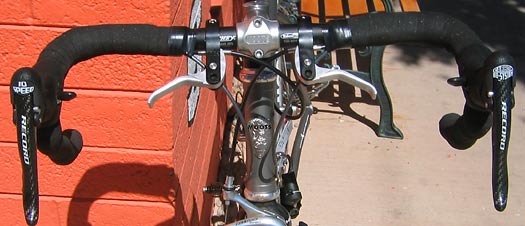

MORE FUN WITH THE VAMOOTS YBB -- The All Road Flyer project:
The drop bar build was perfected over the 2003 and 2004 seasons. In 2006 the build was modified to test our All Road Flyer concept.2006 ~ Testing the flat bar hybrid
In May of 2006 I removed the drop bars, Campy wheels and shifting system. The bike was performing flawlessly and fit me like a glove before the flat bar testing. To begin, I built a pair of Chris King wheels--torquoise (last of the run--goodbye torquoise), DT Competition black spokes and blue nipples, and Mavic Open Pro rims. I installed a 9 speed Dura Ace cogset. Since I was going all out on the conversion, I chose the best shifting system I have ever worked with, SRAM X.0. I replaced the road stem with a Moots mountain unit and replaced the drop bars with a Moots flat bar (23" wide). The bar was wide enough to accommodate the Dreamride ti bar ends. I took the bike out onto the streets and returned to tweak the set up. I flipped the stem for a lower position. I replaced the offset seatpost with a straight up unit for a more forward position. I replaced the saddle with a WTB Pure V ti gel. These modifications, and a lot of tiny finicking adjustments, eventually came together for a perfect fit.
So what is the difference in the flat bar hybrid?
First, the YBB feature really works when your hands are on the grips and the weight is on your butt. The most notable difference between the drops to the flats is that the bike handles more like a very quick mountain bike and less like a twitchy narrow-barred road bike. It makes you wonder why we don't see rigid 29er mountain bikes with this basic road geometry. You can ride along the edge of curbs without a twitch, and turn on a dime without a quiver. The wider bars allow lungs to open up, so breathing is more natural on long climbs. The noticeable advantage to the flat bar and bar ends combo is position on long climbs out of the saddle. The power generated by grabbing the outer reach of the bar ends and pedaling standing up was more than noticeable--it was outstanding! Acceleration is enhanced by the wider, more stable bars, as well. This has a lot to do with the fact that I am a mountain biker by trade, but it is also a testament to that original mountain bike XC race position of the early 90's--a postition that was perfected by road cyclists crossing over into mountain bike racing. I did miss the lower center of gravity afforded by the drops, but with right stem length (a tad longer than would be required by drops) and the bars about 3" below the saddle, weight was on the pedals and distributed across the top tube and between the wheels. All controls were easy to get to, except for the brakes when on the bar ends. Out there on the ends I missed the hoods. Of course I lost the aerodynamic advantage of the drops (and the brake accessibility), but honestly, I was going faster stretched out over the barends like a time trial or tri bike because the leverage is better under power--but NO brakes. Hey, folks, "hybrid" is not a bad word. It may be a better way for some people, especially those who have that "sore back" or want to take the bike on a trail every now and again.

Copyright Dreamride LLC. No material, written, graphics, or photographs on this website, may be reproduced, broadcast, published, re-written, re-edited, or re-used in any way outside of this site without written consent of Dreamride LLC and Lee Bridgers. Use of this site signifies agreement to terms of use.